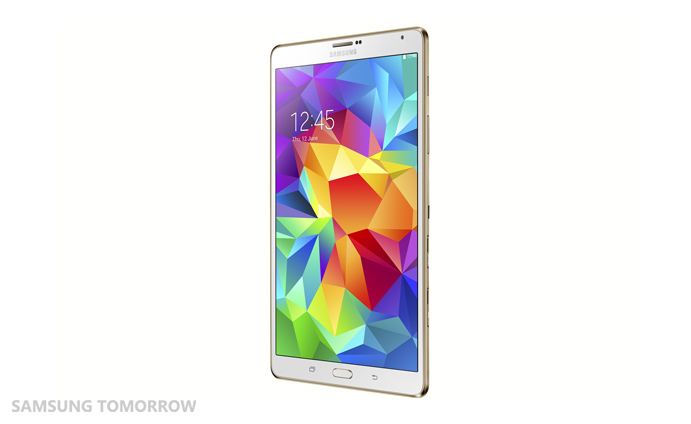
Samsung has trotted out another round of tablets: The 8.4- and 10.5-inch Galaxy Tab S line looks to take on the 7.9- and 9.7-inch iPads by offering larger, more colorful screens while keeping thickness and weight comparable.
The $399 iPad Mini with Retina Display, for instance, measures 0.29 inches thick and weighs 0.73 pounds. The 8.4-inch Galaxy Tab S, by comparison, is 0.26 inches thick and weighs 0.65 pounds. Take the $499 iPad Air: also 0.29 inches thick, and it weighs 1.03 pounds. The 10.5-inch Galaxy Tab S is 0.26 inches thick and weighs 1.025 pounds.
To the average person, the size and weight differences amount to splitting hairs; from a marketing perspective, Samsung gets to claim its tablets are thinner and lighter despite having bigger screens.
As for those Samsung screens, they’re color-rich Super AMOLED screens, each with 2560×1600 resolutions. Apple’s Retina displays are of the IPS variety and sport 2048×1536 resolutions. As far as total resolution goes, it’s another marketing point for Samsung. As for the merits of Super AMOLED versus IPS screen technology, the conclusions aren’t nearly as clear-cut. Here’s a good IPS vs. AMOLED piece if you’re interested. Spoiler: Let your eyes decide.
Samsung — and, by extension, Google — are still playing catch-up to Apple, however, when it comes to tablet-optimized apps. Android has made gains towards stocking its store with bonafide tablet apps recently, but with so many Android devices — both phones and tablets — out there, from a developer’s standpoint, the path of least resistance is to make an app that works well on Android phones and then hope it scales well enough to keep tablet owners happy.

With Apple, you have far fewer devices for which you have to try to build apps: all iPhone models from the iPhone 5 onward have 1136×640 screen resolutions; all the Retina iPads have 2048×1536 resolutions. Your major outliers are the non-Retina iPad Mini and earlier iPhones that are on their way out.
Samsung’s arguably done a good job getting its tablets into the hands of consumers. As The Verge’s Dan Seifert notes, Sammy shipped 40 million tablets last year, against Apple’s 70 million. Samsung has also not been shy about flooding the zone with Galaxy tablets: “Samsung has released at least nine tablets in just the first six months of this year, many of which have overlapping features and designs,” writes Seifert.
And Samsung does have some neat software tricks up its sleeve. This line of tablets will let you dock two apps next to each other, and you have access to a specially-designed, high-definition Netflix app. You also get a feature that mirrors your Samsung phone on the tablet’s screen and Galaxy Gifts, a package of almost 30 time-limited premium services from the likes of Box, WebEX, Evernote and several newspapers.
On paper, this latest tablet salvo from Samsung looks impressive, but now we get to see how consumers react. The 8.4-inch model starts at $399, and the 10.5-inch model starts at $499. Both will be available as Wi-Fi models in July, with LTE versions to follow later in the year.
More Must-Reads from TIME
- Donald Trump Is TIME's 2024 Person of the Year
- Why We Chose Trump as Person of the Year
- Is Intermittent Fasting Good or Bad for You?
- The 100 Must-Read Books of 2024
- The 20 Best Christmas TV Episodes
- Column: If Optimism Feels Ridiculous Now, Try Hope
- The Future of Climate Action Is Trade Policy
- Merle Bombardieri Is Helping People Make the Baby Decision
Contact us at letters@time.com